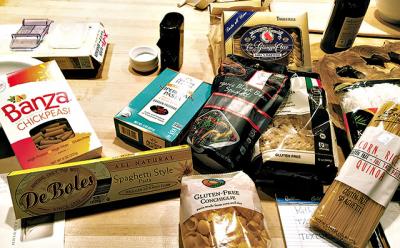Seasons by the Sea: Oodles of (Gluten-Free) Noodles

I have been curious about gluten-free pastas for quite a while, so I conducted a completely scientific taste test in my meticulously organized, pristine kitchen lab. Hah!
In all honesty, I just tasted a bunch with my friends. But I did it in an orderly fashion, cooking each of the eight products as directed on the package, trying them first with a bit of olive oil, butter, and fresh Parmesan, because this is how you may attempt to pawn them off on your children, right? Then I tried them with a simple marinara sauce. I also included “zoodles,” zucchini cut into spaghetti-like strands.
If you are among the 1 percent of the population that genuinely has celiac disease, then you must adhere to a gluten-free diet. Gluten is a protein found in wheat, barley, and rye. You may also have to eliminate farro, bulgur, oats, and more from your diet. If you are among those who believe, or have been diagnosed as having non-celiac gluten sensitivity, or “rich white people problem,” then you are no doubt trying to find tasty alternatives to wheat-laden products. As Mr. T used to say: “I pity the fool!”
My experiment was conducted for no other purpose than taste and texture, and to find out if the claims made on the packaging were, in fact, true. You may think a reputable health food store or company such as Ancient Harvest is telling you the truth when it promises the “taste and texture of traditional pasta,” but it’s just not true, and you will be paying up to five times more than for basic pasta. Beware, also, the package size. The box may look like it contains up to a pound of pasta, but most only contained seven or eight ounces, waaaaay down at the bottom of the box.
I began with black bean pasta. When I opened the package, a faint whiff reminiscent of doggie kibble reached my nostrils. The package also had a very off-putting recipe, basically a Thai-style noodle dish with coconut milk and curry paste, then topped with Parmesan. These noodles were made in China. They started off black as squid-ink pasta but released most of the color into the water, yielding a grey product. The taste was funky and musty, but they had a nice chewy texture.
Next was chickpea. The pasta smelled just like the box it came in. The cooked taste was okay at first, but then developed a sweet, off note. I couldn’t figure out why, but this product was also twice as high in fat as all other pastas.
Next was a corn-quinoa pasta in the shape of garden pagodas. The pagodas rapidly fell apart, thus resembling something more along the lines of a pile of flattened tires, and tasting not much better.
One of the best was Jerusalem artichoke pasta. I got very excited over this. Score! Then I read the label more carefully. The front of the box says, “Made with Jerusalem artichoke flour.” The back of the box listed durum wheat semolina as the first ingredient. Damn you, De Boles, for being misleading, and double damn you, Laura, for not reading the box more carefully!
The corn pasta we tried had a warning on the label that the yellow color would leach out into the water and white specks would appear on the pasta. Neither of these occurred, and the corn was pretty good but also fell apart.
Before I started cooking the various pastas, I had shredded some zucchini for zoodles. Some recipes suggest peeling the zucchini and removing the core. If you do this, you are left with very little material to cook with, much less vitamins and fiber. Some of the recipes also suggested salting, then rinsing, then wringing out in a towel, then cooking for up to seven minutes. That’s a lot of make-work to get a bowl of mush. I opted for a light salting, then a quick rinse in hot water and no cooking.
As I got more and more discouraged over the quality of the products I was tasting, I kept glancing longingly at the strainer full of bright green, familiar, fresh, inexpensive vegetable matter. I would grab a biteful between glutinous blobs of disappointment, and my mouth rejoiced.
Next was a parboiled rice pasta. It was gritty, bland, and had an icky stickiness. Fail.
Food and Wine magazine has tested/tasted gluten-free pastas and concluded that corn and/or quinoa taste best, as does brown rice pasta. America’s Test Kitchen (Cook’s Illustrated) came closer to my conclusions and explained why most of these just don’t work as a substitute for wheat pasta: “Gluten is the protein matrix that gives wheat noodles their structure and pleasant chew.” Corn flour proteins, called prolamins, dissolve in water, hence all the falling apart and mushiness that occurred. Brown rice flour, which contains bran, has a higher amount of proteins and fiber than the others tested. This higher protein and fiber content helps keep the noodles intact when cooking.
The second to last pasta I tried was Jovial’s brown rice pasta, and I agree with the America’s Test Kitchen results that this could be the best gluten-free alternative to wheat pasta. It wasn’t horribly expensive either, at around $3.29 per 12-ounce package.
Finally, we tried the zoodles with a bit of marinara and some good, freshly grated Parmesan cheese. Naturally, they don’t have a chewy texture like pasta, but the uncooked texture gave them body and a bit of resistance. And after all the mostly discouraging results of the others, this was my favorite. It then occurred to me, how about if you combined the brown rice pasta with zoodles for a compromise? You’re welcome!
Click for recipes
